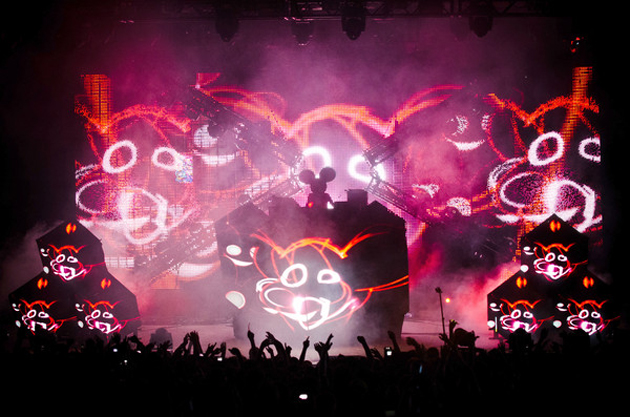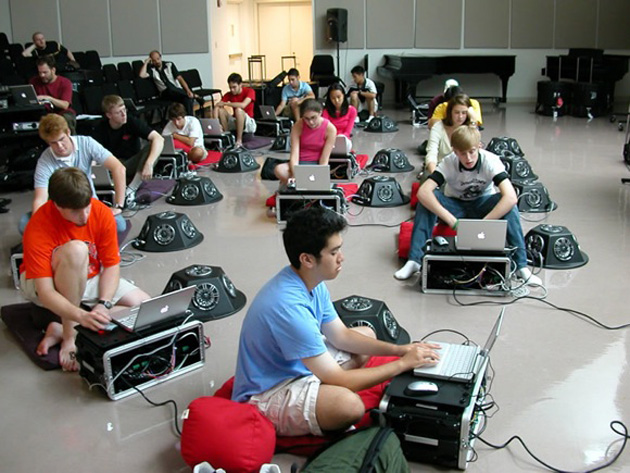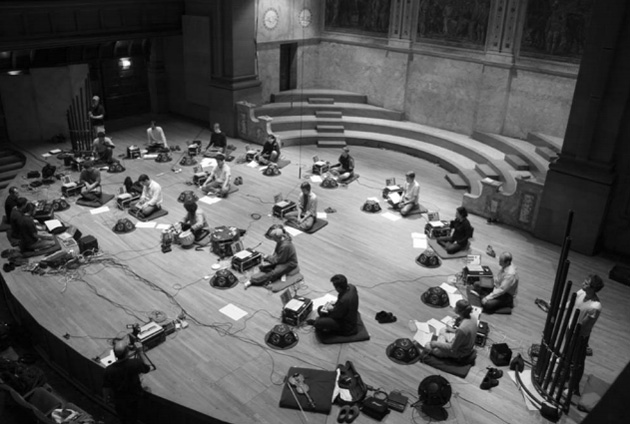 “It’s dull, boring.” “Just a guy pushing buttons.” “What am I supposed to be looking at?”
“It’s dull, boring.” “Just a guy pushing buttons.” “What am I supposed to be looking at?”
How many times have you heard the above sentiments used to describe an electronic music performance? No matter if a synthpop act triggers samples from an Emulator II or DJs at Electric Daisy Carnival fiddle with Ableton, all signify one aspect of electronic music: Performers must try harder to put on a show.
Rock contemporaries, in a sense, have it easy. Just get up on the stage and play for an hour or two. The performance essentially speaks for itself, as all technique and music-making abilities are apparent. But, electronic? The genre, even from its early days, has lived under the “just pushing play” dark cloud, regardless of the instruments or technology used.
Visuals, as dance music took off in the 1990s, became the go-to approach to creating a spectacle. Add a DJ, include a few lights and projections, and the show’s good to go. Festivals, especially in recent years, have exhausted this approach. Worse, the visuals turn into a distraction obscuring mediocre DJing. Artists realize this and, this year, have experimented with innovative approaches.
Just Playing Live
Boys Noize, for his recent U.S. tour, explained he is doing his first live show. “Live” electronic music, on the other hand, can be interpreted in a number of ways. First, a “traditional” DJing set – mixing and doing mashups without prerecording a playlist – falls into this camp, as does adding a synthesizer or the full, complex setups of electronica acts, who essentially rebuild their studios out on stage.
The producer, DJ, and label manager born Alex Ridha came upon this approach by accident. “At one point I was just making an iTunes playlist with all of my jams, and I was surprised by how easily I could just play my music and get away with it, in a way,” he told Spin.
Concertgoers should expect to hear an exclusively Boys Noize setlist, played with traditional DJing techniques. Ridha, unlike a large percentage of his festival-headlining peers, actually relied mostly on other artists’ tracks beforehand. “Most of the time I got away with just playing a couple of my tracks and then mixing it up with other stuff. That’s how I’ve done it all the years,” he explained.
Although electronic dance music essentially originated in the ‘70s, instruments like synthesizers and theremins and techniques like tape playback took off in the mid 20th century through classical music and continue to have a place in modern compositions. The film score for The Day The Earth Stood Still, for instance, is notable for its usage of the antennae-shaped instrument.

Taking this a step up, in the context of live electronic music, are laptop orchestras, detailed in CreateDigitalMusic.com in 2007 but proliferating up through the present. Although ensemble configurations, and laptop usage varies, laptop orchestras embody old and new methods of creating classical music, according to an article about PLOrk. Also known as the Princeton Laptop Orchestra, PLOrk, detailed in the 2005 piece, features 15 performance stations for its musicians, each with a multi-directional speaker, software, a multi-channel audio interface, sensor interface, and keyboards, graphics tablets, and drum pads for plugging in. A wired audio network connects all stations.
Education Under a Concert Guise
Less than a month before Boys Noize went on the road in the U.S., Richie Hawtin, along with other artists, hit a series of North American colleges for his CNTRL Tour. But, unlike the college tours of Tiesto and Avicii, Hawtin set out to educate the U.S. on electronic music.
Is Hawtin, a 20-year veteran of the industry, preaching to the choir? Hardly. Although electronic music is huge in the college market, it’s restricted to a handful of chart-toppers. Hawtin, as well as tourmates like Loco Dice, Seth Troxler, and Kevin Saunderson, seem too obscure, too difficult to listen to, too complex – even when slapped with the “minimalism” label.
“Our CNTRL Tour is meant to widen their musical spectrum,” Hawtin explained in an interview to O.C. Weekly. “It’s not to say what we do is better, or what we do is worse. The idea that electronic music is getting bigger and bigger in America is an incredible force. We just want to see the music continue to evolve and people to continue to get into electronic music on a very deep level.”
Along with music, CNTRL introduced college students to DJing and producing.
A 360-Degree, Multimedia Experience
Still, visuals remain the core element of breathing life into electronic music performance. “The visuals are kind of our lead singer,” Paul Hartnoll told Wired.co.uk in August 2011. “They’re the lead singer jumping around and pulling faces.”
Projections and lights, on the other hand, are tired and overused. So, this year, certain events and acts amped it up. Cosmic Opera, featuring Axwell of Swedish House Mafia, aimed for such an all-encompassing experience. Beyond just visuals was a story, performed by Baroque-era performers, dancers, and acrobats. Axwell, along with other electronic artists, acted as the event’s conductor.
Kraftwerk, with its retrospective at the Museum of Modern Art, took a similar approach. The eight-day concert series, held in a 75 foot tall atrium for a concert-meets-studio-sessions feel, incorporated three-dimension visual effects and footage from their music videos.




